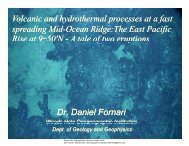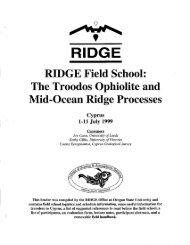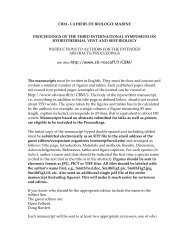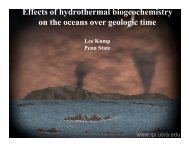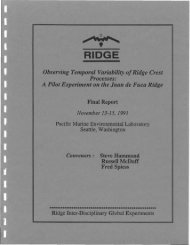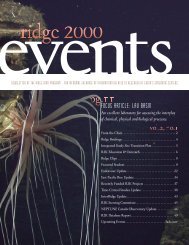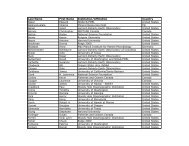You also want an ePaper? Increase the reach of your titles
YUMPU automatically turns print PDFs into web optimized ePapers that Google loves.
detailed investigation of the seafloor and the subsurface<br />
crust. High temperature hydrothermal vents. for instance. were<br />
discussed only as theoretical possibilities before their<br />
discovery in the Pacific in the late 1970s. Such vent fields<br />
and their associated biological communities were not observed on<br />
slow spreading ridge crests until 1985. High resolution swath<br />
mapping and side-scan sonar imaging have only recently begun to<br />
yield a rich return of information on the detailed morphology<br />
and structure of ridge systems. including such discoveries as<br />
the existence of overlapping spreading centers and major<br />
along-strike variations in volcanic and tectonic processes.<br />
Multi-channel seismic imaging techniques have advanced to the<br />
stage where widespread mapping of the prominent reflector<br />
thought to mark the roof of the axial magma chamber has been<br />
initiated. The Global Positioning Satellite system promises to<br />
reduce ship navigational errors to a few tens of meters on a<br />
routine basis. permitting easy intercomparison of data sets and<br />
assured placement of instrumentation for experiments.<br />
Much of the promise of this new technology remains to be<br />
realized. Detailed sampling and mapping of the mid-ocean ridge.<br />
for instance. has been confined to date only to a small fraction<br />
of its total length. The range in diversity of volcanic and<br />
tectonic processes manifested along the ridge axis. as a consequence.<br />
has not yet been fully defined. More fundamentally.<br />
the complex and interlinked processes of magmatism. hydrothermal<br />
circulation. development of vent communities. and lithospheric<br />
evolution are only dimly understood. The dynamics of these<br />
processes have not yet been elucidated because of the lack of<br />
in situ observations of sufficient duration and diversity to<br />
determine the important interactions and time scales.<br />
For these reasons. the Ocean Studies Board convened a workshop<br />
on the mid-ocean ridge. The workshop participants were<br />
asked to summarize our current understanding of the processes of<br />
generation and evolution of oceanic lithosphere. to identify the<br />
primary objectives for ridge crest science in the next decade.<br />
and to outline a research program capable of meeting these<br />
objectives. The workshop proceedings presented here are the<br />
response to that charge.<br />
In organizing the workshop. the Steering Committee attempted<br />
to assure that a wide spectrum of views from the entire oceanographic<br />
community would be represented. More than 80 individuals<br />
representing physical. chemical. and biological oceanography<br />
and marine geology and geophysics were invited to participate.<br />
The list of participants is included in Appendix I.<br />
Before the workshop. a number of participants were asked to<br />
prepare papers on the state of our understanding of the<br />
principal dynamical processes occurring at the mid-ocean ridge.<br />
with an emphasis on the major scientific questions currently<br />
outstanding. Additional papers were solicited on promising<br />
techniques for addressing these questions. The background<br />
2






